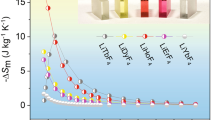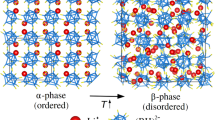Abstract
Magnetic cooling could be a radically different energy solution substituting conventional vapour compression refrigeration in the future. For the largest cooling effects of most potential refrigerants we need to fully exploit the different degrees of freedom such as magnetism and crystal structure. We report now for Heusler-type Ni–Mn–In–(Co) magnetic shape-memory alloys, the adiabatic temperature change ΔTad = −3.6 to −6.2 K under a moderate field of 2 T. Here it is the structural transition that plays the dominant role towards the net cooling effect. A phenomenological model is established that reveals the parameters essential for such a large ΔTad. We also demonstrate that obstacles to the application of Heusler alloys, namely the usually large hysteresis and limited operating temperature window, can be overcome by using the multi-response to different external stimuli and/or fine-tuning the lattice parameters, and by stacking a series of alloys with tailored magnetostructural transitions.
This is a preview of subscription content, access via your institution
Access options
Subscribe to this journal
Receive 12 print issues and online access
$259.00 per year
only $21.58 per issue
Buy this article
- Purchase on Springer Link
- Instant access to full article PDF
Prices may be subject to local taxes which are calculated during checkout





Similar content being viewed by others
References
Gschneidner, K. A. Jr, Pecharsky, V. K. & Tsokol, A. O. Recent developments in magnetocaloric materials. Rep. Prog. Phys. 68, 1479–1539 (2005).
Giauque, W. F. A thermodynamic treatment of certain magnetic effects. A proposed method of producing temperatures considerably below 1° absolute. J. Am. Chem. Soc. 49, 1864–1870 (1927).
Pecharsky, V. K. & Gschneidner, K. A. Jr Giant magnetocaloric effect in Gd5(Si2Ge2). Phys Rev. Lett. 78, 4494–4497 (1997).
Moore, J. D. et al. Metamagnetism seeded by nanostructural features of single-crystalline Gd5Si2Ge2 . Adv. Mater. 21, 3780–3783 (2009).
Fujita, A., Fujieda, S., Hasegawa, Y. & Fukamichi, K. Itinerant-electron metamagnetic transition and large magnetocaloric effects in La(FexSi1−x)13 compounds and their hydrides. Phys Rev. B 67, 104416 (2003).
Hu, F. X. et al. Influence of negative lattice expansion and metamagnetic transition on magnetic entropy change in the compound LaFe11.4Si1.6 . Appl. Phys. Lett. 78, 3675–3677 (2001).
Lyubina, J., Nenkov, K., Schultz, L. & Gutfleisch, O. Multiple metamagnetic transitions in the magnetic refrigerant La(Fe,Si)13Hx . Phys Rev. Lett. 101, 177203 (2008).
Tegus, O., Brück, E., Buschow, K. H. J. & de Boer, F. R. Transition-metal-based magnetic refrigerants for room-temperature applications. Nature 415, 150–152 (2002).
Yan, A., Müller, K. H., Schultz, L. & Gutfleisch, O. Magnetic entropy change in melt-spun MnFePGe. J. Appl. Phys. 99, 08K903 (2006).
Gutfleisch, O. et al. Magnetic materials and devices for the 21st century: Stronger, lighter, and more energy efficient. Adv. Mater. 23, 821–842 (2011).
Kainuma, R. et al. Magnetic-field-induced shape recovery by reverse phase transformation. Nature 439, 957–960 (2006).
Chmielus, M., Zhang, X. X., Witherspoon, C., Dunand, D. C. & Müllner, P. Giant magnetic-field-induced strains in polycrystalline Ni–Mn–Gafoams. Nature Mater. 8, 863–866 (2009).
Manosa, L. et al. Giant solid-state barocaloric effect in the Ni–Mn–In magnetic shape memory alloy. Nature Mater. 9, 478–481 (2010).
Krenke, T. et al. Inverse magnetocaloric effect in ferromagnetic Ni–Mn–Sn alloys. Nature Mater. 4, 450–454 (2005).
Liu, J., Woodcock, T. G., Scheerbaum, N. & Gutfleisch, O. Influence of annealing on magnetic field induced structural transformation and magnetocaloric effect in Ni–Mn–In–Co ribbons. Acta Mater. 57, 4911–4920 (2009).
Pecharsky, V. K. & Gschneidner, K. A. Jr Gd5(SixGe1−x)4: An extremum material. Adv. Mater. 13, 683–686 (2001).
Pecharsky, V. K., Gschneidner, K. A. Jr, Mudryk, Y. & Paudyal, D. Making the most of the magnetic and lattice entropy changes. J. Magn. Magn. Mater. 321, 3541–3547 (2009).
Khovaylo, V. V., Skokov, K. P. & Gutfleisch, O. et al. Peculiarities of the magnetocaloric properties in Ni–Mn–Sn ferromagnetic shape memory alloys. Phys. Rev. B 81, 214406 (2010).
Moya, X. et al. Cooling and heating by adiabatic magnetization in the Ni50Mn34In16 magnetic shape-memory alloy. Phys. Rev. B 75, 184412 (2007).
Aksoy, S. et al. Tailoring magnetic and magnetocaloric properties of martensitic transitions in ferromagnetic Heusler alloys. Appl. Phys. Lett. 91, 241916 (2007).
Bourgault, D., Tillier, J., Courtois, P., Maillard, D. & Chaud, X. Large inverse magnetocaloric effect in Ni45Co5Mn37.5In12.5 single crystal above 300 K. Appl. Phys. Lett. 96, 132501 (2007).
Khan, M., Ali, N. & Stadler, S. Inverse magnetocaloric effect in ferromagnetic Ni50Mn37+xSb13−x Heusler alloys. J. Appl. Phys. 101, 053919 (2007).
Caron, L. et al. On the determination of the magnetic entropy change in materials with first-order transitions. J. Magn. Magn. Mater. 321, 3559–3566 (2009).
Liu, J., Scheerbaum, N., Lyubina, J. & Gutfleisch, O. Reversibility of magnetostructural transition and associated magnetocaloric effect in Ni–Mn–In–Co. Appl. Phys. Lett. 93, 102512 (2008).
Umetsu, R. Y. et al. The effect of Co substitution on the magnetic properties of the Heusler alloy Ni50Mn33Sb17 . Appl. Phys. Lett. 98, 042507 (2011).
Pecharsky, V. K., Gschneidner, K. A. Jr, Pecharsky, A. O. & Tishin, A. M. Thermodynamics of the magnetocaloric effect. Phys Rev. B 64, 144406 (2001).
Zverev, V. I., Tishin, A. M. & Kuz’min, M. D. The maximum possible magnetocaloric ΔT effect. J. Appl. Phys. 107, 043907 (2010).
Ortin, J. & Planes, A. Thermodynamics of thermoelastic martensitic transformations. Acta Metall. 37, 1433–1441 (1989).
Shamberger, P. J. & Ohuchi, F. S. Hysteresis of the martensitic phase transition in magnetocaloric-effect Ni–Mn–Sn alloys. Phys Rev. B 79, 144407 (2009).
Krenke, T. et al. Hysteresis effects in the magnetic-field-induced reverse martensitic transition in magnetic shape-memory alloys. J. Appl. Phys. 108, 043914 (2010).
Basso, V., Sasso, C. P. & LoBue, M. Thermodynamic aspects of first-order phase transformations with hysteresis in magnetic materials. J. Magn. Magn. Mater. 316, 262–268 (2007).
Pecharsky, V. K. & Gschneidner, K. A. Jr in A. Magnetism and Structure in Functional Materials (eds Planes, A. et al.) Ch. 11 (Springer Series on Materials Science, Springer, 2006).
Morrison, K., Moore, J. D., Sandeman, K. G., Caplin, A. D. & Cohen, L. F. Capturing first- and second-order behavior in magnetocaloric CoMnSi0.92Ge0.08 . Phys. Rev. B 79, 134408 (2009).
Magen, C., Morellon, L. & Algarabel, P. A. et al. Hydrostatic pressure control of the magnetostructural phase transition in Gd5Si2Ge2 single crystals. Phys. Rev. B 72, 024416 (2005).
Manosa, L., Moya, X., Planes, A., Gutfleisch, O. & Lyubina, J. et al. Effects of hydrostatic pressure on the magnetism and martensitic transition of Ni–Mn–In magnetic superelastic alloys. Appl. Phys. Lett. 92, 012515 (2008).
Muthu, S. E. et al. Hydrostatic pressure effect on the martensitic transition, magnetic, and magnetocaloric properties in Ni50−xMn37+xSn13 Heusler alloys. J. Appl. Phys. 110, 083902 (2011).
Oliveira, N. A. Entropy change upon magnetic field and pressure varitions. Appl. Phys. Lett. 90, 052501 (2007).
Bhattacharya, K. & James, R. D. The material is the machine. Science 307, 53–54 (2005).
Zarnetta, R., Takahashi, R. & Young, M. L. et al. Identification of quaternary shape memory alloys with near-zero thermal hysteresis and unprecedented functional stability. Adv. Funct. Mater. 20, 1917–1923 (2010).
Krenke, T. et al. Magnetic superelasticity and inverse magnetocaloric effect in Ni–Mn–In. Phys. Rev. B 75, 104414 (2007).
Srivastava, V., Song, Y. T., Bhatti, K. & James, R. D. The direct conversion of heat to electricity using multiferroic alloys. Adv. Energy Mater. 1, 97–104 (2011).
Cui, J. et al. Combinatorial search of the thermoelastic shape-memory alloys with extremely small hysteresis width. Nature Mater. 5, 286–290 (2006).
Ito, W. et al. Atomic ordering and magnetic properties in the Ni45Co5Mn36.7In13.3 metamagnetic shape memory alloy. Appl. Phys. Lett. 93, 232503 (2008).
Flores, R., Franco, V., Conde, A., Knipling, K. E. & Willard, M. A. Optimization of the refrigerant capacity in multiphase magnetocaloric materials. Appl. Phys. Lett. 98, 102505 (2011).
Yu, S. Y. et al. Magnetic field-induced martensitic transformation and large magnetoresistance in NiCoMnSb. Appl. Phys. Lett. 90, 242501 (2007).
Acknowledgements
The research leading to these results has received financial support from Deutsche Forschungsgemeinschaft (SPP 1239) and the European Community’s 7th Framework Programme under grant agreement No. 214864 (SSEEC). Thanks to K. Nenkov for technical support and to M. D. Kuz’min, K. H. Müller and K.G. Sandeman for fruitful discussions.
Author information
Authors and Affiliations
Contributions
J.L., K.P.S. and T.G. designed and performed the experiments. J.L., K.P.S., T.G. and J.D.M. analysed the data. J.L. wrote the manuscript with the support of J.D.M.,T.G. and O.G. O.G. led projects.
Corresponding authors
Ethics declarations
Competing interests
The authors declare no competing financial interests.
Supplementary information
Supplementary Information
Supplementary Information (PDF 1466 kb)
Rights and permissions
About this article
Cite this article
Liu, J., Gottschall, T., Skokov, K. et al. Giant magnetocaloric effect driven by structural transitions. Nature Mater 11, 620–626 (2012). https://doi.org/10.1038/nmat3334
Received:
Accepted:
Published:
Issue Date:
DOI: https://doi.org/10.1038/nmat3334
This article is cited by
-
Structural, Magnetic, and Transport Properties of MnNiGa Ribbon
Journal of Superconductivity and Novel Magnetism (2024)
-
Combining Ab Initio and Monte Carlo Methods to Study the Electronic, Magnetic, and Magnetocaloric Properties of \(\hbox {GaFeCo}_2\) Full-Heusler Material
Journal of Electronic Materials (2024)
-
Effect of Sintering Temperature on the Magnetocaloric Effect of Ni-Mn-In/Tb-Dy-Fe Composites
Journal of Superconductivity and Novel Magnetism (2024)
-
Effects of Electric and Magnetic Treatments on Microstructures of Solid Metals: A Review
Chinese Journal of Mechanical Engineering (2023)
-
Calculation of magnetocaloric effect with regard for dependence of heat capacity on magnetic field
Scientific Reports (2023)



